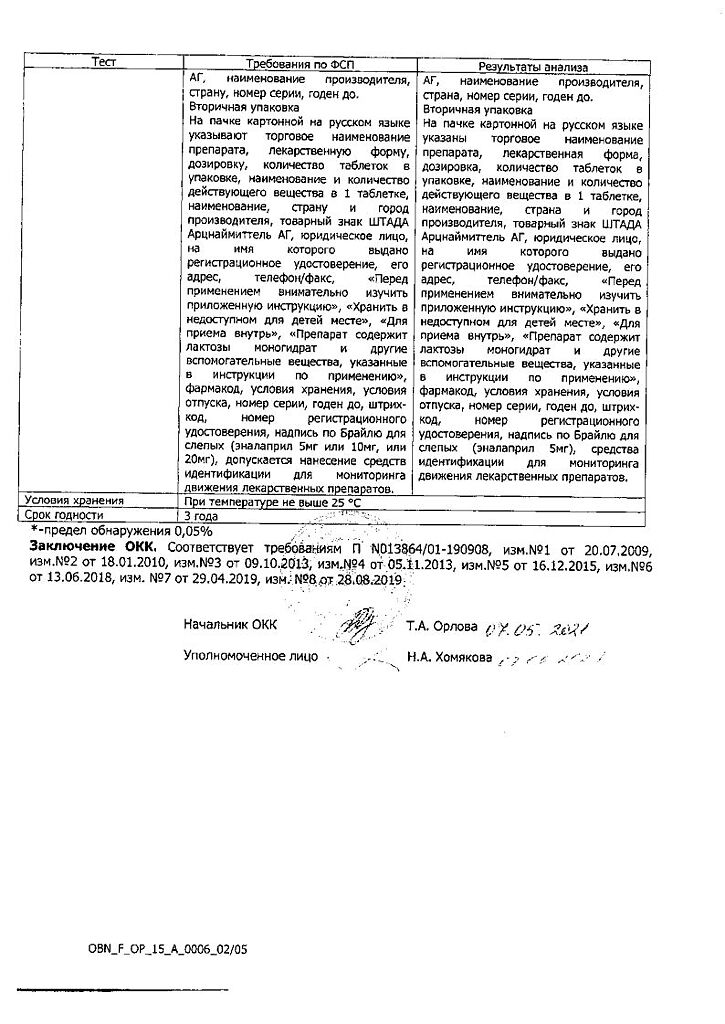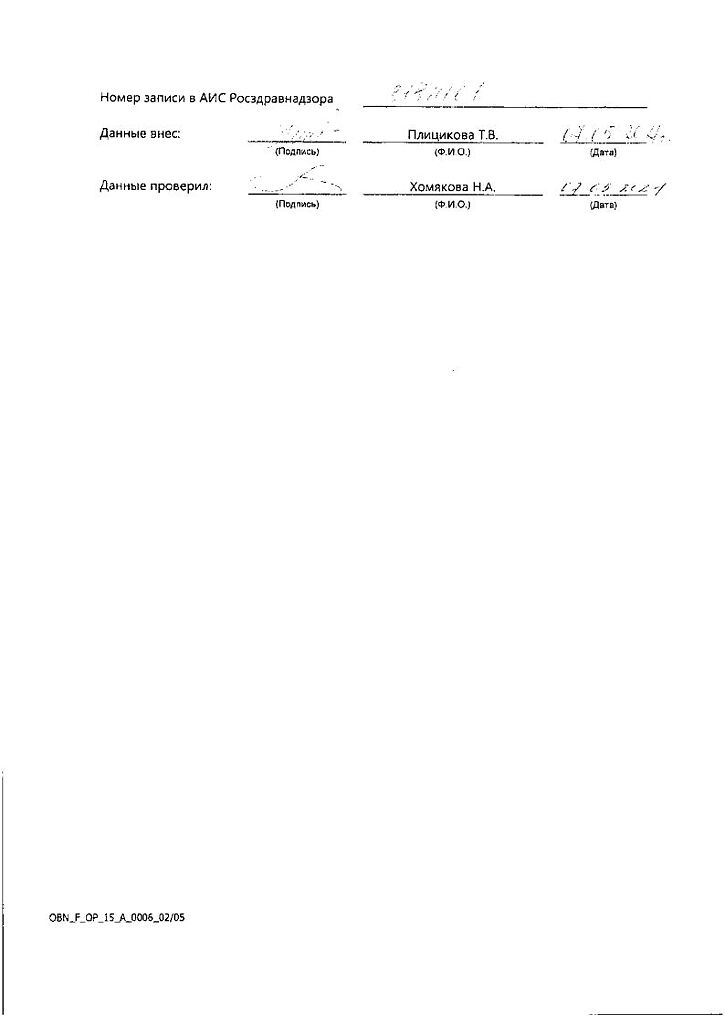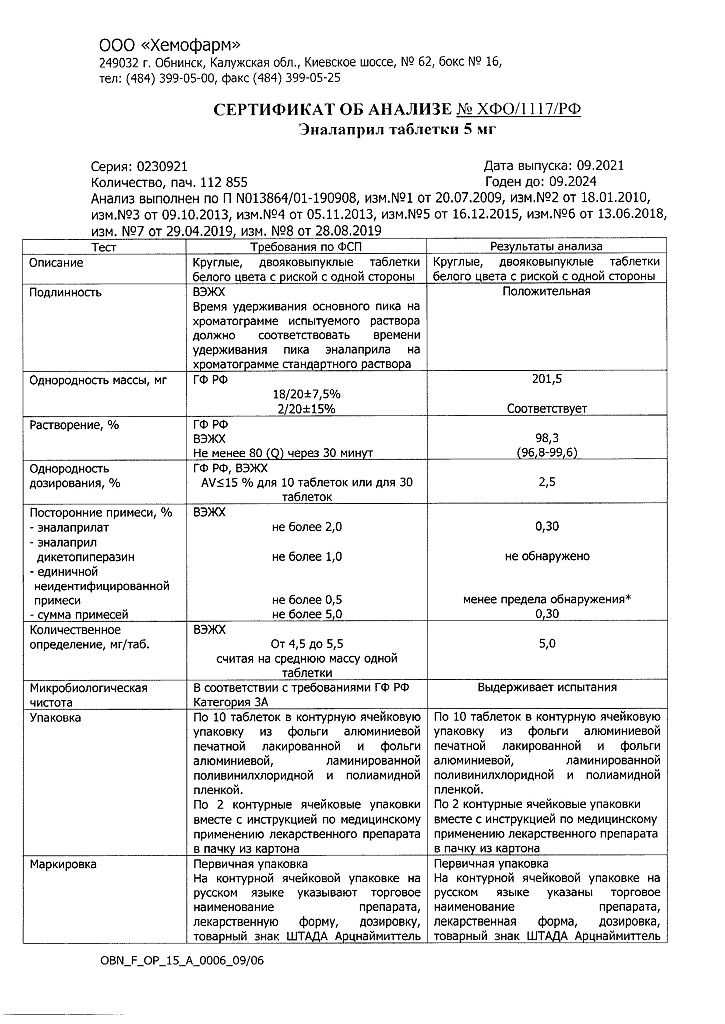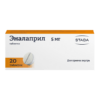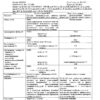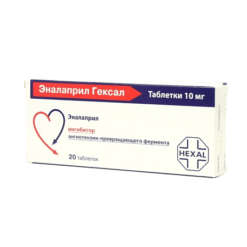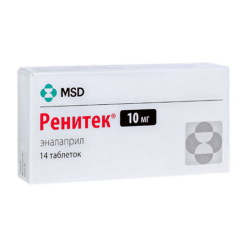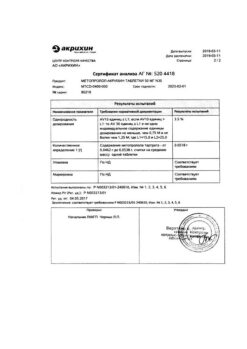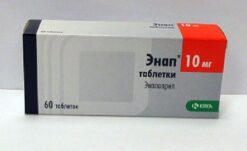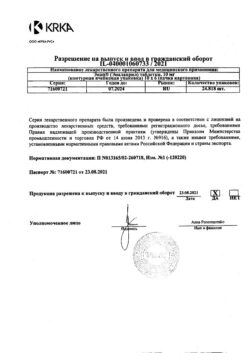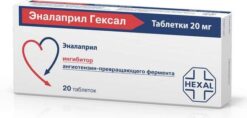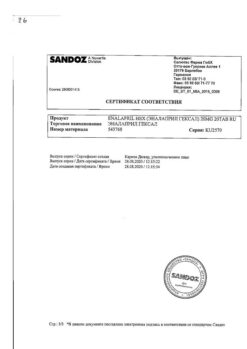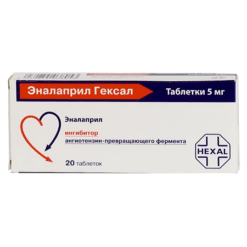No products in the cart.
Enalapril, tablets 5 mg 20 pcs
€2.50 €2.08
Description
Enalapril is an angiotensin-converting enzyme inhibitor. Enalapril has a dilating effect on arteries and to a lesser extent on veins.
Enalapril has a more pronounced hypotensive effect when plasma renin concentrations are elevated. The use of Enalapril improves renal and coronary blood flow.
Long-term use of Enalapril reduces left ventricular myocardial hypertrophy and prevents development of chronic heart failure.
Enalapril has a stimulating effect on myocardial blood flow. It reduces platelet aggregation.
Enalapril is indicated to slow the development of left ventricular dysfunction in patients who have had a myocardial infarction.
Enalapril has been reported to have some diuretic effect.
Enalapril is a “prodrug” that by hydrolysis forms enalaprilate, which in turn inhibits the angiotensin-converting enzyme.
Hypotensive effect occurs 1 hour after taking Enalapril and lasts for 24 hours.
Some patients require therapy for several weeks to achieve optimal blood pressure readings.
Patients with chronic heart failure require a course of at least 6 months of treatment for a noticeable clinical effect.
Indications
Indications
Prevention of coronary ischemia; arterial hypertension; patients with left ventricular myocardial dysfunction.
Pharmacological effect
Pharmacological effect
Enalapril is an angiotensin-converting enzyme inhibitor. Enalapril has a dilating effect on the arteries and, to a lesser extent, on the veins.
The hypotensive effect of Enalapril is more pronounced with increased concentrations of renin in the blood plasma. When using Enalapril, renal and coronary blood flow improves.
Long-term use of Enalapril reduces left ventricular hypertrophy of the myocardium and prevents the development of chronic heart failure.
Enalapril has a stimulating effect on the blood supply to the myocardium. Reduces platelet aggregation.
Enalapril is indicated to slow the progression of left ventricular dysfunction in patients who have had myocardial infarction.
According to the reviews received, Enalapril has some diuretic effect.
Enalapril is a “prodrug” that, by hydrolysis, forms enalaprilat, which in turn inhibits the angiotensin-converting enzyme.
The hypotensive effect occurs 1 hour after taking Enalapril and continues for 24 hours.
Some patients require therapy for several weeks to achieve optimal blood pressure readings.
For patients with chronic heart failure, a course of treatment of at least 6 months is required to obtain a noticeable clinical effect.
Special instructions
Special instructions
Caution must be exercised when prescribing Enalapril to patients with reduced circulating blood volume (as a result of diuretic therapy, limiting salt intake,
hemodialysis, diarrhea and vomiting) – there is an increased risk of a sudden and pronounced decrease in blood pressure after using even the initial dose of an ACE inhibitor.
Transient arterial hypotension is not a contraindication for continuing treatment with the drug after stabilization of blood pressure.
In case of a repeated pronounced decrease in blood pressure, the dose should be reduced or the drug discontinued. The use of highly permeable dialysis membranes increases the risk of developing an anaphylactic reaction.
Correction of the dosage regimen on days free from dialysis should be carried out depending on the level of blood pressure. Before and during treatment with ACE inhibitors, periodic monitoring of blood pressure, blood parameters (hemoglobin, potassium, creatinine, urea, liver enzyme activity), and protein in the urine is necessary.
Patients with severe heart failure, coronary heart disease and cerebrovascular disease, in whom a sharp decrease in blood pressure can lead to myocardial infarction, stroke or impaired renal function, should be carefully monitored.
Sudden cessation of treatment does not lead to withdrawal syndrome (a sharp rise in blood pressure). It is recommended that newborns and infants exposed in utero to ACE inhibitors be monitored
careful observation for the timely detection of a pronounced decrease in blood pressure, oliguria, hyperkalemia and neurological disorders, possible due to a decrease in renal and cerebral blood flow with a decrease in blood pressure caused by ACE inhibitors.
In oliguria, it is necessary to maintain blood pressure and renal perfusion by administering appropriate fluids and vasoconstrictors.
The drug should be prescribed with caution to patients with diabetes mellitus due to the risk of developing hyperkalemia.
Patients with a history of angioedema may have an increased risk of developing angioedema during treatment with Enalapril.
Patients with severe autoimmune diseases, such as systemic lupus erythematosus or scleroderma, are at increased risk of developing neutropenia or agranulocytosis while taking Enalapril.
It is recommended to exercise caution when prescribing Enalapril for the treatment of chronic heart failure in patients receiving cardiac glycosides and/or diuretics.
Before studying the functions of the parathyroid glands, the drug should be discontinued. Alcohol enhances the hypotensive effect of the drug. Before surgery (including dentistry), the surgeon/anesthesiologist must be warned about the use of ACE inhibitors.
Use in patients with impaired renal function: in the presence of renal failure, the excretion of the active metabolite may be reduced, leading to an increase in its concentration in the blood plasma. Such patients may need to be prescribed smaller doses of the drug. In patients with arterial hypertension and unilateral or bilateral renal artery stenosis, an increase in urea and creatinine in the blood serum is possible.
In such patients, renal function should be monitored during the first few weeks of therapy. It may be necessary to reduce the dosage of the drug.
The balance of risk and potential benefit should be taken into account when prescribing Enalapril to patients with coronary and cerebrovascular insufficiency, due to the risk of increased ischemia with excessive arterial hypotension.
Impact on the ability to drive vehicles and operate machinery: at the beginning of treatment, until the end of the dose selection period, it is necessary to refrain from driving vehicles and engaging in potentially hazardous activities that require increased concentration and speed of psychomotor reactions, as dizziness is possible, especially after the initial dose of an ACE inhibitor in patients taking diuretics.
Active ingredient
Active ingredient
Enalapril
Composition
Composition
1 tablet 5 mg contains:
Active substance:
Enalapril maleate – 5 mg.
Excipients:
Lactose monohydrate – 106,000 mg,
Magnesium carbonate – 71.645 mg,
Gelatin – 7,800 mg,
Crospovidone – 7,800 mg,
Magnesium stearate – 1.755 mg.
Pregnancy
Pregnancy
Contraindicated for use during pregnancy.
If pregnancy occurs, enalapril should be stopped immediately.
Enalapril is excreted in breast milk.
If it is necessary to use it during lactation, the issue of stopping breastfeeding should be decided.
Contraindications
Contraindications
Hypersensitivity to enalapril and other ACE inhibitors, a history of angioedema associated with treatment with ACE inhibitors, porphyria, pregnancy, lactation, age under 18 years (efficacy and safety have not been established).
Use with caution in case of primary hyperaldosteronism, bilateral renal artery stenosis, stenosis of the artery of a single kidney, hyperkalemia, condition after kidney transplantation; aortic stenosis,
mitral stenosis (with hemodynamic disturbances), idiopathic hypertrophic subaortic stenosis, systemic connective tissue diseases, coronary heart disease, cerebrovascular diseases,
diabetes mellitus, renal failure (proteinuria – more than 1 g/day), liver failure, in patients on a salt-restricted diet or on hemodialysis, while taking immunosuppressants and saluretics, in elderly people (over 65 years).
Side Effects
Side Effects
Orthostatic collapse, rarely – palpitations, chest pain, pulmonary embolism, arrhythmias (atrial fibrillation, atrial brady- or tachycardia), angina pectoris, myocardial infarction; fainting, dizziness, weakness, headache, paresthesia, insomnia, depression, anxiety, confusion, drowsiness (2-3%), increased fatigue, very rarely when the dosage is exceeded – depression, nervousness; dry mouth, impaired biliary function, dyspeptic disorders (diarrhea or constipation, nausea, vomiting), intestinal obstruction, abdominal pain, pancreatitis, jaundice, hepatitis; pharyngitis, rhinorrhea, shortness of breath, bronchospasm, interstitial pneumonitis, nonproductive cough; glossitis, stomatitis, arthritis, arthralgia, myositis, vasculitis, serositis, photosensitivity, urticaria, pruritus, epidermal necrolysis, pemphigus (pemphigus), exudative erythema multiforme, exfoliative dermatitis, dysphonia, angioedema, facial skin rash; eosinophilia, agranulocytosis, thrombocytopenia, neutropenia, increased ESR, decreased Hb and hematocrit, hyponatremia, hyperkalemia, increased transaminase activity, hypercreatininemia, hyperbilirubinemia, increased urea concentration, proteinuria; decreased libido, alopecia.
Interaction
Interaction
When Enalapril is co-administered with non-steroidal anti-inflammatory drugs (NSAIDs), the hypotensive effect may be reduced.
With potassium-sparing diuretics (spironolactone, triamterene, amiloride) can lead to hyperkalemia.
With lithium salts – to slow down the excretion of lithium (monitoring the concentration of lithium in the blood plasma is indicated).
Concomitant use with antipyretics and analgesics may reduce the effectiveness of enalapril. Enalapril weakens the effect of drugs containing theophylline.
The hypotensive effect of enalapril is enhanced by diuretics, beta-blockers, methyldopa, nitrates, blockers of “slow” calcium channels, hydralazine, prazosin.
Immunosuppressants, allopurinol, cytostatics increase hematotoxicity. Drugs that cause bone marrow suppression increase the risk of developing neutropenia and/or agranulocytosis.
Overdose
Overdose
Symptoms:
a pronounced decrease in blood pressure up to the development of collapse, myocardial infarction, acute cerebrovascular accident or thromboembolic complications, convulsions, stupor.
Treatment:
the patient is transferred to a horizontal position with a low headboard. In mild cases, gastric lavage and ingestion of saline solution are indicated; in more severe cases, measures aimed at stabilizing blood pressure are indicated:
intravenous administration of saline, plasma substitutes, if necessary, administration of angiotensin II, hemodialysis (the elimination rate of enalaprilat is on average 62 ml/min).
Storage conditions
Storage conditions
Store in a dry place, at a temperature of 15 to 25C.
Keep out of the reach of children.
Shelf life
Shelf life
3 years.
Do not use after expiration date.
Manufacturer
Manufacturer
Hemofarm LLC, Russia
Additional information
| Shelf life | 3 years. Do not use after the expiration date. |
|---|---|
| Conditions of storage | Store in a dry place at a temperature of 15 to 25C. Store out of the reach of children. |
| Manufacturer | Chemopharm LLC, Russia |
| Medication form | pills |
| Brand | Chemopharm LLC |
Other forms…
Related products
Buy Enalapril, tablets 5 mg 20 pcs with delivery to USA, UK, Europe and over 120 other countries.


